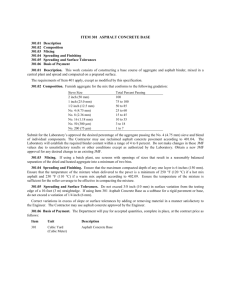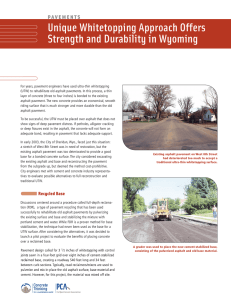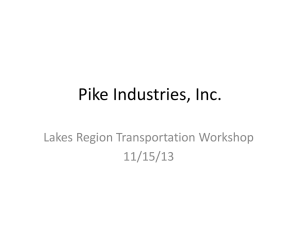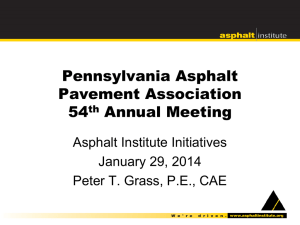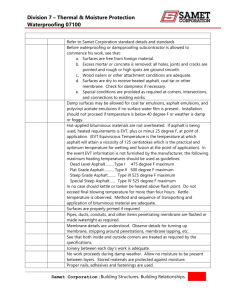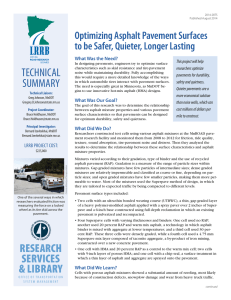Pavement Structure and Materials
advertisement
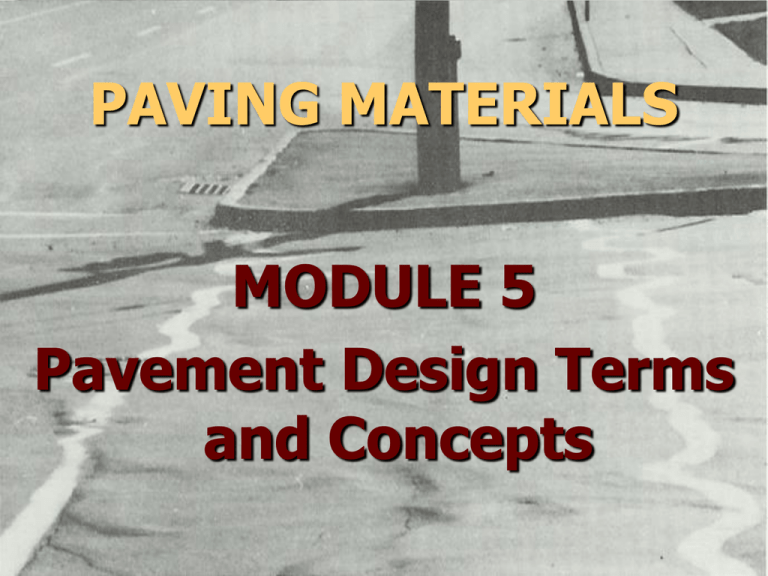
PAVING MATERIALS MODULE 5 Pavement Design Terms and Concepts Technically, what is a pavement? “Black Top” or “Tarvy” ? “to pave” means “to cover with asphalt, gravel, concrete, macadam, etc.” A surface ? Why build pavements? Transportation Originally, footpaths sufficed Increasing traffic and loads Quality John Issues: drainage, subgrade materials Macadam, 1756 - 1836 5.01 Define the term pavement as it is given by the MTO's Pavement Design and Rehabilitation Manual . "Pavements are layered structures of selected and processed materials which have been designed to resist surficial wear, to support wheel loads and provide drainage of water." PAVEMENT TYPES 5.02 Identify the various pavement types according to the following three classification methods: a) Surface Type b) Load Transmission c) Composition a) Surface Type: Bound or Unbound b) Load Transmission FLEXIBLE 40 kN Load RIGID 40 kN Load Typical deflection signatures Stress is transmitted through bound surface layer to underlying granular layers Bound surface (slab) distributes stress over a broader area, thus reducing the amount of stress transmitted to underlying material c) Composition: Type of materials used and arrangement/installation technique Portland Cement Concrete (PCC) Asphalt Cement Concrete (Hot or Cold Mix) Surface Treatment Mulch 5.03 Identify the 3 key components to a pavement structure. SURFACE GRANULAR BASE GRANULAR SUBBASE 5.04 List the 4 functions of bituminous surface materials. provides resistance to surface wear reduces surface water infiltration provides a smooth and rideable finish provides structural support to wheel loads 5.05 Identify the two broad classes of asphalt pavement surfaces and give examples for each. MIX SYSTEMS Hot and Cold Mixed Asphaltic Concrete Hot and Cold Mixed Stabilized Base Recycled Hot and Cold Mixed Asphaltic Concrete Travel Plant Mixes (cold) Slurry Seal LAYERED SYSTEMS Penetration Primer Surface Treatment Macadam 5.06 Describe the materials and manufacture of Hot Mix Asphaltic Concrete. Materials: a mixture of fine and coarse aggregate with asphalt cement Manufacture: components are heated and mixed in a central plant mixture is hauled to site in special trucks and placed on the road using an asphalt spreader Manufacture (Continued): designed, manufactured and placed within specified tolerances for use on high traffic volume roads 5.07 Identify the use(s) of the following MTO designations: HL 1, 2, 3, 4 and 8; HL 3 Fine; HL 3, 4 and 8 Modified; Heavy Duty Binder; DFC; OFC; and Electrically Conductive Mix. These MTO mixes are described in Table 5.01 5.08 Describe the materials and manufacture of Cold Mix Asphaltic Concrete. Materials: a mixture of emulsified asphalt or liquid (cutback) asphalt and aggregate Manufacture: components are mixed at ambient air temperature can be mixed in a central plant or in-situ on the road surface with a travelling mixer such as the Midland Mix Paver or road mix mulch pavements Manufacture (Continued): aggregate and emulsified asphalt are delivered to Midland Mix Paver separately and blended in a pug mill augers distribute mixture to a screed which uniformly controls the thickness of the cold mix layer once the emulsified asphalt in the mixture surface starts to break or set, the mixture is compacted use in Ontario generally restricted to low volume rural roads, where HMAC surfaced pavements are not required 5.09 Describe the materials used and general placement method for Surface Treatments. consist of an application of emulsified or liquid asphalt and select aggregate over a prepared granular base or existing surface 5.10 List the reasons for applying surface treatments to: a) granular road surfaces, and b) existing surface treatments or asphaltic concrete a) to control water b) to restore frictional infiltration, provide resistance and reduce frictional resistance, water infiltration improve ride quality & control dust and stone pick-up in general, on light to medium volume roads 5.11 Describe the materials/placement and primary application for: Mulch Pavements, Slurry Seals, Fog Seals, Primers, Tack Coats and Granular Seals. These treatments are described in Table 5.02 5.12 Identify the origin of asphalt cement and the MTO grade specifications (test and designations). the majority of asphalt cements come from petroleum distillation as do liquid (cutback) asphalts and asphalt emulsions (see next slide) MTO has graded asphalt cements by standard penetration number (PEN); eg: 85/100 (hardest), 150/200, 300/400, 500+ (softest) SUPERPAVE is a new mix design method that replaces this grading system Atkins, 2nd Ed. 5.13 Describe the 2 conflicting problems related to asphalt cement grade faced in Ontario. if a soft grade is used then rutting is a problem in the hot summers Before: After: if a hard grade is used then low temperature (transverse) cracking is a problem in the winter

